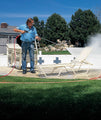The Ultimate Guide to Understanding Pressure Washers: Components and Functionality
Published:
08/13/2024
Pressure Washers are powerful tools designed to clean surfaces with high-pressure water. They’re commonly used to clean driveways, sidewalks, patios, siding, and even vehicles.
In this article, we’ll delve into the key components of a pressure washer and explain how each part contributes to its overall functionality.
Every hot water pressure washer in the world works the same way. You need a pump to move the water at a certain flow, a coil to heat the water, and a nozzle to pressurize the water. Everything else on the machine makes these components work the way you want them to.
The machine's frame is designed to be compact and hold all the components in a logical configuration to work together.

Tank
The tanks hold the water or fuel needed to operate the equipment.
Controls
The controls provide a means to turn on and off the pump, burner, and detergent. They also protect the equipment and the operator.
Water Inlet
The water inlet is where the pressure washer is connected to a water supply. This connection can be a garden hose or a dedicated water source. The inlet typically includes a filter to prevent debris from entering the pressure washer and causing damage.
Water
The operation of the pressure washer is fairly simple. The water is pulled or pushed into the pump with a garden hose or float tank. Since a pressure washer heats moving water at a certain flow, the water source needs to be constant. With 40 lbs of line pressure on average 8 - 12 gallons of water will be supplied to the machine. Most water supplies today are large enough to handle almost any pressure washer.
Pump
The pump is responsible for taking in water from the inlet and pressurizing it. This component is driven by electric motors with various voltages or by gas engines, depending on the customer's needs. The size depends on how much water is moved in a minute (gallons per minute - GPM) and by the pressure the machine is made to produce (pounds per square inch - PSI).
Axial Cam Pumps
Are commonly found in consumer-grade pressure washers.
Triplex Plunger Pumps
Are used in professional-grade models due to their durability and efficiency.
Unloader Valve
From the pump, the water is pushed to a coil. The water may go through an unloader valve if the machine has a trigger gun unit. The trigger gun controls the water flow by stopping the flow of water when the trigger is released. Then the unloader recirculates the water back to the pump since it can’t go out to the wand with the gun closed, this is called putting the machine into by-pass mode. If the machine is an open water system, which is rare, no trigger gun or unloader is used.
Coil
The coil on a hot water machine is used to transfer the heat from the burner system to the water as efficiently as possible. Since the water is under pressure these coils must also stand pressures exceeding 4000 PSI. From the coil, the water is pushed out through a wire-braided pressure hose.
Pressure Hose
Pressure hoses come in various lengths, with the most standard lengths being 50, 75, and 100 feet but can be up to 200 feet or longer if needed. These hoses are designed to withstand the high pressure of the water, typically ranging from 1,300 to 4,000 PSI.
At the end of the hose is the trigger gun and wand assembly, this is used to direct the spray to where you need it.
Pressure Nozzle
The nozzle pressurizes the water by restricting the water from exiting the wand building back pressure thus creating the pressure spray and forming the water into the common spray patterns of 0, 15, 25, or 40 Degrees.
Conclusion
Understanding the components and operation of a pressure washer can help users select the right model for their needs and use it more effectively. From the water inlet to the nozzle, each part plays a crucial role in delivering the high-pressure water that makes pressure washers such powerful cleaning tools.
Whether you’re tackling light cleaning tasks or heavy-duty jobs, knowing how your pressure washer works will ensure you get the best results every time.
Share this Article ↓




